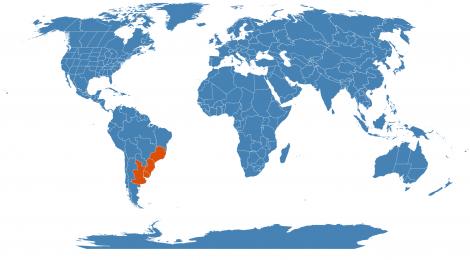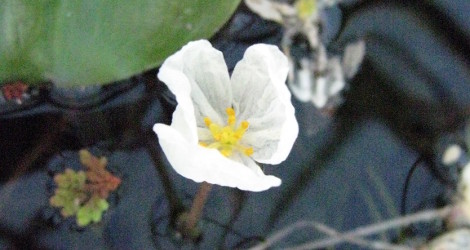Accession Data:
Egeria densa Planch.
- Common Name: Brazilian Elodea
- Family: Hydrocharitaceae Juss.
- Country of Origin: central Minas Gerais region of Brazil and coastal Argentina and Uruguay

- Habitat: submersed, freshwater perennial herb, generally rooted on the bottom
- Description: syn. Elodea densa (Planch.) Casp.; Anacharis densa (Planch.) Vict.
Submersed aquatic dioecious herb, stems stout, several feet long; leaves crowded, in whorls of 4-5, linear-lanceolate, to 1.5 inches long and 3/16 inch wide; filaments club-shaped, female flowers with petals to 5/16 inch long; fruit 5/16 inch long.
- Culture:
pH: 6.5-8.0
6-20 dH
59-75°F (15-24°C)
It will tend to be paler and thinner if grown in softer, more acidic water.
Moderate to bright light, does fine in plain gravel substrate.
- USDA Zone: 5a-11
Accession Data:
- Accession # 200700213
- Source: Robert Capers
- Provenance:
Robert Capers Mono Pond, Columbia, CT 11/13/07
- Accession Date: 11-14-2007
- Bench: 6902 - Array 1, Tank 2
- Currently: active - healthy
- Qty: 1 confirmed on 03-03-2025
- Restrictions:
- Potentially Invasive Plant - Plants are not to leave Greenhouse!
- Potentially Invasive Plant - Plants are not to leave Greenhouse!
Classification:
- Division: Magnoliophyta
- Class: Liliopsida
- SubClass: monocots
- Order: Alismatales
- SubOrder:
- Family: Hydrocharitaceae
- SubFamily:
- Tribe:
- SubTribe:
Flowering Data:
This accession has been observed in bloom on:| Year | Jan | Feb | Mar | Apr | May | Jun | Jul | Aug | Sep | Oct | Nov | Dec | ||||||||||||||||||||||||||||||||||||||||
|---|---|---|---|---|---|---|---|---|---|---|---|---|---|---|---|---|---|---|---|---|---|---|---|---|---|---|---|---|---|---|---|---|---|---|---|---|---|---|---|---|---|---|---|---|---|---|---|---|---|---|---|---|
| 2025 | ||||||||||||||||||||||||||||||||||||||||||||||||||||
| 2024 | ||||||||||||||||||||||||||||||||||||||||||||||||||||
| 2023 | ||||||||||||||||||||||||||||||||||||||||||||||||||||
| 2022 | ||||||||||||||||||||||||||||||||||||||||||||||||||||
| 2021 | ||||||||||||||||||||||||||||||||||||||||||||||||||||
| 2020 | ||||||||||||||||||||||||||||||||||||||||||||||||||||
| 2019 | ||||||||||||||||||||||||||||||||||||||||||||||||||||
| 2018 | ||||||||||||||||||||||||||||||||||||||||||||||||||||
| 2017 | ||||||||||||||||||||||||||||||||||||||||||||||||||||
| 2016 | ||||||||||||||||||||||||||||||||||||||||||||||||||||
| 2015 | ||||||||||||||||||||||||||||||||||||||||||||||||||||
| 2014 | ||||||||||||||||||||||||||||||||||||||||||||||||||||
| 2013 | ||||||||||||||||||||||||||||||||||||||||||||||||||||
| 2012 | ||||||||||||||||||||||||||||||||||||||||||||||||||||
| 2011 | ||||||||||||||||||||||||||||||||||||||||||||||||||||
| 2010 | ||||||||||||||||||||||||||||||||||||||||||||||||||||
| 2009 | ||||||||||||||||||||||||||||||||||||||||||||||||||||
| 2008 | ||||||||||||||||||||||||||||||||||||||||||||||||||||
References (internal):
- EEB Greenhouse Holdings native to: Brazil Southeast / Brazil South / Argentina Northeast / Uruguay
References (external):
- Hortus Third, LH Bailey Hortorium, 1976
- The Plant List (2013). Version 1.1. Last accessed on Wednesday, September 07, 2016.
- WCSP (2016). World Checklist of Selected Plant Families. Facilitated by the Royal Botanic Gardens, Kew. Last accessed on Wednesday, September 07, 2016.
data regenerated on Mon, 03 Mar 2025 11:09:02 -0500 [bcm v4.0]
Images:

Additional images for this accession:
Click on thumbnails to enlargeCurrent Accessions in the Hydrocharitaceae
W/C = Wild Collected = indicates flowering in past 14 days
= indicates flowering in past 14 days
 = images available for this accession
= images available for this accession
 = map available for this accession
= map available for this accession
 = accession added within past 90 days
= accession added within past 90 days
